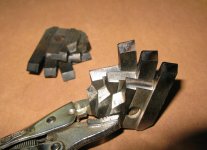I run a small 1" wide moulding cutters (HSS) along with the planer blades in one of my planers, to make a Shiplap siding profile.
When I am working with nice clear old growth Redwood, the blades hold up ok, but when I am running knotty second growth, the moulding/shiplap cutters take quite a beating, planer blades are fine.
My question is, I would like to have these shiplap cutters made out of carbide, but don't know if solid carbide would stand up to the beating these take, as they are only 1/8" thick and stick out from the head almost an inch. I don't see any of the laminated carbide/steel material that the carbide blades are made of, that have a full lamination of carbide that would cover the whole profile, usually it's only about 3/8" along the cutting edge.
I could go to 1/4" thick blades, any suggestions?
Thanks
janc
When I am working with nice clear old growth Redwood, the blades hold up ok, but when I am running knotty second growth, the moulding/shiplap cutters take quite a beating, planer blades are fine.
My question is, I would like to have these shiplap cutters made out of carbide, but don't know if solid carbide would stand up to the beating these take, as they are only 1/8" thick and stick out from the head almost an inch. I don't see any of the laminated carbide/steel material that the carbide blades are made of, that have a full lamination of carbide that would cover the whole profile, usually it's only about 3/8" along the cutting edge.
I could go to 1/4" thick blades, any suggestions?
Thanks
janc










